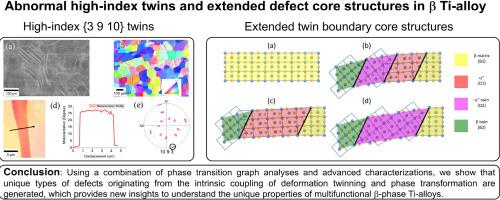Unique twinning mode and extended twin boundary core structure associated with symmetry breaking in a multifunctional Ti-Nb-based alloy
IF 8.3
1区 材料科学
Q1 MATERIALS SCIENCE, MULTIDISCIPLINARY
引用次数: 0
Abstract
Recently, a class of multifunctional Ti-Nb-based alloys has been developed, exhibiting exceptional mechanical and physical properties, such as high strength, high ductility, low-modulus superelasticity, and Invar/Elinvar anomalies. These properties are closely linked to the co-evolution of various microstructural defects, including dislocations, twins, and second-phase domains. In this study, we show the formation of unique defects, such as {3 9 10} twins and extended twin boundary core structures, in a cold-rolled Ti-24Nb-4Zr-8Sn-0.2O (wt.%) alloy. These defects arise from the intrinsic coupling between phase transformation and deformation twinning. Using a phase transition graph approach, we demonstrate that these high-index twins and extended defect core structures originate from the correlated broken symmetry associated with multiple crystal deformation processes. By establishing a symmetry-based link between deformation paths and characteristic defects, our work offers a new perspective for investigating the deformation mechanisms and unique properties of metallic materials.


求助全文
约1分钟内获得全文
求助全文
来源期刊

Acta Materialia
工程技术-材料科学:综合
CiteScore
16.10
自引率
8.50%
发文量
801
审稿时长
53 days
期刊介绍:
Acta Materialia serves as a platform for publishing full-length, original papers and commissioned overviews that contribute to a profound understanding of the correlation between the processing, structure, and properties of inorganic materials. The journal seeks papers with high impact potential or those that significantly propel the field forward. The scope includes the atomic and molecular arrangements, chemical and electronic structures, and microstructure of materials, focusing on their mechanical or functional behavior across all length scales, including nanostructures.
 求助内容:
求助内容: 应助结果提醒方式:
应助结果提醒方式:


